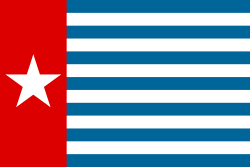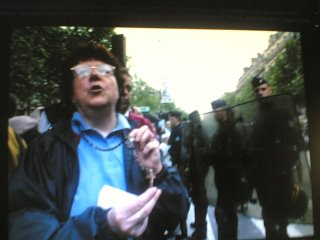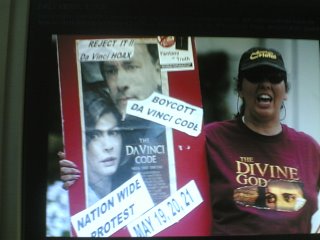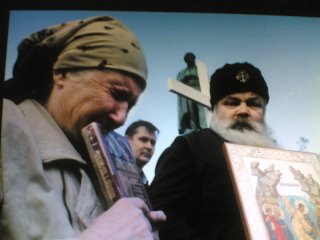WEST PAPUA
Western New Guinea is the western half of the island of New Guinea. It is currently internationally recognized as Papua, a province of Indonesia, and was previously known by various names, including Netherlands New Guinea (until 1962), West Irian (1962-1973), and Irian Jaya (1973-2000). The incorporation of western New Guinea remains controversial in some quarters, including some quarters within the area itself, and those who do not recognize the legitimacy of Indonesia's claim to Papua refer to the area as West Papua.
Papua was annexed by Indonesia under the controversial Act of Free Choice in 1969. In 2003, the Indonesian central government declared that the province would be split into three provinces: Papua Province, Central Irian Jaya Province, and West Irian Jaya Province. Opposition to this resulted in the plan for Central Irian Jaya province being scrapped, and even the designation of West Irian Jaya Province is still legally unclear. The independent sovereign state of Papua New Guinea (PNG) borders Papua Province to the east.
HistoryPapuans, the native people of New Guinea, are a Pacific Melanesian people, as are those of the Solomons, Vanuatu, New Caledonia and Fiji. Papuans have inhabited the Australasian continental island of Papua for over 40,000 years while Austronesians have been there for several thousand years. These groups have developed diverse cultures and languages in situ; there are over 300 languages and two hundred additional dialects in West New Guinea alone (See Papuan languages, Austronesian languages).
It is believed that the first Europeans to sight New Guinea were the Portuguese, but it was the Dutch vessel Duyfken which first recorded its travel along the southern coast of Papua in 1605. The Duyfken did not explore the coast of Papua, but sailed south into the Gulf of Carpentaria, landing in northern Australia.
"Hai Tanahku Papua" ("Oh My Land Papua"), HAI TANAHKU PAPUA Hai Tanahku Papua,Kau Tanah Lahirku,Ku Kasih Akan Dikau,Sehingga Ajalku. Kukasih Hutan-hutan,Selimut Tanahku,Ku Suka Mengembara,Dibawah Naungmu. Kukasih Pasir Putih,Dipantaimu Senang,Dimana Lautan Biru,Berkilat Dalam Trang. Kukasih Engkau Tanah,Yang Dengan Buahmu,Membayar Kerajinan,Dan Pekerjaanku. Kukasih Bunyi Ombak,Yang Pukul Pantaimu,Nyanyian Yang Selalu,Senangkan Hatiku. Syukur Bagi-Mu Tuhan,Kaubrikan Tanahku,Bri Aku Rajin Juga,Sampaikan Maksud-Mu. Kukasih Gunung-gunung,Besar Mulialah,Dan Awan Yang Melayang,Keliling Puncaknya. Papuan appeal UN recognition of self-determinationBy Press Release: Radio New Zealand InternationalMay 25, 2006, 14:53
Email this article Printer friendly page Press Release: Radio New Zealand InternationalPapuan leader appeals for UN recognition to self-determination
The leader of the Koteka Tribal Assembly of West Papua, Benny Wenda, says the UN should do the proper thing by recognising Papuans right to self determination.
A statement by Mr Wenda was presented during the current session of the UN’s Permanent Forum on Indigenous Issues as he couldn’t get to New York because of visa complications.
He says the forum should ask the UN to carry out a review of the so-called 1969 Act of Free Choice, hold a genuine referendum on the right to self determination, and place Papua on the decolonisation list.
Mr Wenda says if the UN believes it is a organisation that protects choice and rights then it should behave like one in the case of Papua.
“We are like victimised by international law that we didn’t get an opportunity or right to self-determination and we know that UN itself broke its own rule.”
Hai tanah ku Papoea,Kau tanah lahirku,Ku kasih akan dikau sehingga adjalku. Kukasih pasir putihDipantaimu senangDimana Lautan biruBerkilat dalam trang. Kukasih gunung-gunungBesar mulialahDan awan jang melajangKeliling puntjaknja. Kukasih dikau tanahJang dengan buahmuMembajar keradjinanDan pekerdjaanku. Kukasih bunji ombakJang pukul pantaimuNjanjian jang selaluSenangkan hatiku.
Kukasih hutan-hutanSelimut tanahkuKusuka mengembaraDibawah naungmu. Sjukur bagimu, Tuhan,Kau brikan tanahkuBri aku radjin djugaSampaikan maksudMu



















